
My blog post on Industry’s call for modern Rosies-the-Riveters (Oct. 27: Manufacturers to women: 'Daughters of Rosie, we need you!') inspired a response from Lois Anderson (no relation), who overcame male distrust to get companies in Michigan to, well, Excel. Lois writes:
I read your article with great respect for the women represented by Rosie the Riveter, and great joy for those of us who continued the fight to be included and respected by our male counterparts.
For many years I was the corporate training manager for Dexter Axle. Prior to that I taught for Southwestern Michigan College in their College at Work program. That program saw me going from plant to plant and teaching courses such as “Introduction to Computers” and “Quality Assurance,” using Microsoft Excel as a tool to improve efficiencies at companies in Paw Paw, Berrien Springs, Niles, and many other places.
When I first suggested to some supervisors at a tool & die company in Berrien Springs that they could improve their workflow and quality by using Excel to track which dies would run the best on which machines--the supervisors rolled their eyes at me. I could hear them thinking, “What does this woman know about our processes?”
The superintendent of the plant had a different take. “Dr. Lois,” he asked, “how did you know that?”
I explained how in every manufacturing process there are quality-assurance methods that not only improve quality, they also improve efficiency and effectiveness (to borrow from Edwards Deming and Peter Drucker).
The supervisor responded that they just cannot afford to take the time to put certain dies on certain machines. I replied, “You cannot afford not to take the time to put certain dies on certain machines.” As he learned to use Excel for tracking the efficiency of usage, I made a convert. Me—this little 5-ft. woman, made a convert of a plant superintendent with decades of experience.
Once the plant superintendent was onboard with the process of tracking quality along with efficiency of usage—the rest was history. I became accepted by everyone in the plant as an expert who could be counted on to provide training and ideas that would make the company more profitable. The plant manager, who initially was not happy with this mere woman sent out by a college, became a convert as well.
Yes, women in manufacturing are here to stay.
Lois Anderson, Proud Daughter of Rosie
Lois added a PS: “I am retired and now use many metalworking techniques to create jewelry. Guess what? Different dies still perform differently in my hydraulic press and rolling mill.”
Related Glossary Terms
- metalworking
metalworking
Any manufacturing process in which metal is processed or machined such that the workpiece is given a new shape. Broadly defined, the term includes processes such as design and layout, heat-treating, material handling and inspection.
- milling machine ( mill)
milling machine ( mill)
Runs endmills and arbor-mounted milling cutters. Features include a head with a spindle that drives the cutters; a column, knee and table that provide motion in the three Cartesian axes; and a base that supports the components and houses the cutting-fluid pump and reservoir. The work is mounted on the table and fed into the rotating cutter or endmill to accomplish the milling steps; vertical milling machines also feed endmills into the work by means of a spindle-mounted quill. Models range from small manual machines to big bed-type and duplex mills. All take one of three basic forms: vertical, horizontal or convertible horizontal/vertical. Vertical machines may be knee-type (the table is mounted on a knee that can be elevated) or bed-type (the table is securely supported and only moves horizontally). In general, horizontal machines are bigger and more powerful, while vertical machines are lighter but more versatile and easier to set up and operate.
- sawing machine ( saw)
sawing machine ( saw)
Machine designed to use a serrated-tooth blade to cut metal or other material. Comes in a wide variety of styles but takes one of four basic forms: hacksaw (a simple, rugged machine that uses a reciprocating motion to part metal or other material); cold or circular saw (powers a circular blade that cuts structural materials); bandsaw (runs an endless band; the two basic types are cutoff and contour band machines, which cut intricate contours and shapes); and abrasive cutoff saw (similar in appearance to the cold saw, but uses an abrasive disc that rotates at high speeds rather than a blade with serrated teeth).







